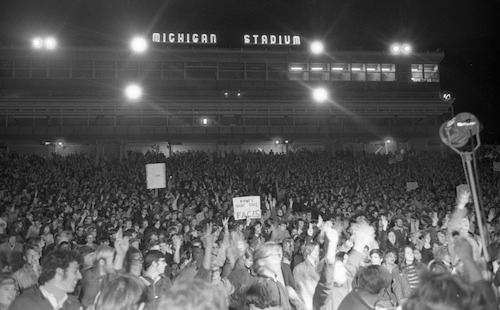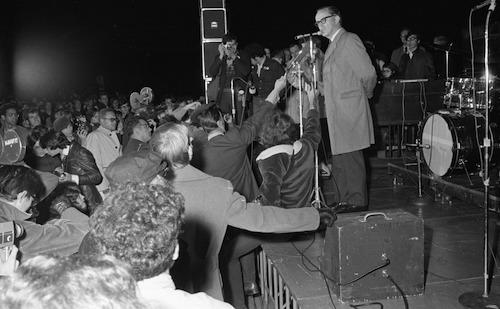Lima Center Interurban Station
Janice Stevenson, owner of Wackenhut Gartens, says people often guess that her store at Jackson and Lima Center roads was originally a church or a school. A former resident reported that people often knocked at his door thinking it was the township hall.
Community High School
Community High School (CHS) is an alternative public high school serving grades 9-12 located at 401 North Division Street in Ann Arbor's historic Kerrytown District. It was one of the first magnet schools to arise from a nation-wide wave of experimental schools that drew on the social movements of the late 1960s and early 1970s, and was specifically influenced by social and political activism in Ann Arbor at the time.
Endangered Pentastar
A unique structure on Ann Arbor's west side is for sale and its ultimate fate unknown.
Naylor Motor Sales' five-sided showroom on W. Stadium is based on the "pentastar," the logo comprised of five triangles that Chrysler introduced in 1962 to represent the five brands it sold at the time--Chrysler, Plymouth, Dodge, Imperial, and Dodge trucks. "I hoped Chrysler Corporation would adopt [the showroom design] and make me famous, but that didn't happen," says architect Ted Smith, who designed it in 1965.
The October 15, 1969 Peace Rally
The peace rally at Michigan Stadium on October 15, 1969, was the largest of all the anti-war protests in the 1960s in Ann Arbor. Including some 20,000 attendees, the rally was the culmination of Ann Arbor’s participation in a nationwide event - The Moratorium to End the War in Vietnam - that took place that day, with many businesses, churches, and colleges across the country closing to protest continued involvement in the War. Related events at the University of Michigan included teach-ins and forums, and the day concluded with a 6 p.m. torchlight parade winding from the University of Michigan central Diag to Michigan Stadium, followed by a rally inside the Stadium.

Rally organizers were New Mobilization leader Douglas Dowd of Cornell University and Ann Arbor Mobilization leader Eugene Gladstone. Speakers included U.S. Senator Philip A. Hart; SDS founder and Chicago 8 member, Tom Hayden; U. S. Representative John Conyers; State Senator Coleman Young; State Representative Roger Craig; Eugene Charles of the Black Panthers; Rhoades W. Murphy, U-M geography professor; and Ann Arbor City Councilman for the Third Ward, Nicholas Kazarinoff. The local rock band SRC performed at the Rally. Both the U-M parade and rally remained peaceful, a minor incident occurring when a participant near the speakers' platform spit on speaker Tom Hayden and was removed by Ann Arbor police.

A month earlier, on September 19, in a speech at Hill Auditorium during the “Tactic-In” events on the University of Michigan campus, U-M President Robben Fleming came out against the war in Vietnam and promised to make University facilities available for the upcoming October 15 Moratorium. He further indicated that if enough people came out to express opposition to the War during the event, he would personally deliver their message to Washington. Fleming’s anti-war declaration was controversial at the time, as was his endorsement of a University venue for an anti-war protest; however, his decision, made on the heels of many contentious campus-wide protests that had occurred in preceding months - most significantly, the 1969 South University Riot - signaled his evolving belief that suppressing protests would only lead to violence.
In the days after the Moratorium, President Fleming remained true to his word and wrote a letter to Washington stating that the mood on the University of Michigan campus was one of “broad and deep opposition. This opposition is not simply emotional, it is thoughtful. It does not occur because of ignorance, but only after sober reflection.”
The Washtenaw Alano Club
Since 1969, the Washtenaw Alano Club (WAC) has fulfilled its mission “to provide a facility and environment conducive to spiritual growth for recovery from addictive behavior” by hosting a variety of 12-step recovery groups and offering social, educational, and recreational activities.
WAC currently serves 1,500 visitors each week over the course of 72 meetings covering eighteen distinct 12-step programs. Among these are: Al-Alanon, ACOA, AlaTeen, Narcotics Anonymous, Sexaholics Anonymous, Gamblers Anonymous, and Artists Recovering Through the Twelve Steps.

History & Founders
WAC was founded in 1969 through the efforts of a group of people in recovery who decided Ann Arbor needed its own Alano Club. WAC is currently one of numerous Clubs nationwide that host regular meetings and other social events for people in recovery. Some of the early community leaders and members who played a role in establishing WAC are: Leo H. Evans, Grace J. Yesley, Allen L. Rendel, Richard Hammerstein, Judge Sandy J. Elden, James H. Fondren, Rev. Robert C. Grigereit, Ronald D. Rinker, Dr. Margaret Clay, Mrs. Robert Harris, James W. Henderson, Dr. Russell F. Smith, Patricia O'Sullivan, Gerald H. Voice, Ed L. Clark, Margaret E. Brooks, Patricia Goulet, Paul Clark, Elaine Ambrose, Barry Kistner, Steve Carr, and Dr. George S. Fischmann.
WAC filed articles of incorporation on October 27, 1969, and first began meeting at an older house on North Main Street. However, this location's cramped quarters and lack of parking weren't ideal and by March 1970, business meetings were being held once a month at the Calvary Methodist Church at 1415 Miller Avenue. On July 1, 1971, the Club drafted its first By-Laws, and on April 6, 1973, WAC was officially granted 501(c)(3) non-profit status. Meanwhile, original charter member, Leo H. Evans, initiated fundraising efforts to find a more suitable meeting space and in September 1975, WAC signed a lease for its first home in the Fourth Avenue Arcade at 212 South Fourth Avenue in downtown Ann Arbor. They moved in on November 23.

After three years, the reputation of this particular block of Fourth Avenue, which at the time included both liquor stores and adult bookstores, encouraged the group to begin scouting for a new location. For a short period, beginning in August 1978, this location would be an office building at 2500 Packard Rd, Suite 204; then, on November 4, 1980, WAC moved to 2761 South State Street. During the seven years at the State Street location, the Club expanded services to include additional activities and social events such as volleyball and softball teams.
995 North Maple Road
Late in the summer of 1986, WAC was notified its lease would not be renewed and the State Street building would be sold. With only 60 days to vacate, members scrambled to find a new location. At this time, they learned that the Ann Arbor Public School Board was selling property at 995 North Maple Road - the former Fritz School building - which had served as both an elementary school and alternative school within the Ann Arbor Public School system. Although WAC was not the highest bidder for the property, it was granted the bid of $127,500, due in part to members on the School Board who supported the Club’s mission to serve the community. The Ann Arbor City Council also approved a rezoning request to permit WAC to use the building.

WAC now owns the building at 995 North Maple. Set on a large parcel of oak woods with picnic areas, parking, and a rain garden, its interior space consists of meeting rooms, a lounge, and a concession area. Its first major project was to build a parking lot, and a 1992 fundraising drive helped to replace the aging roof. The work of several Board committees has contributed to other improvements to both interior and exterior spaces over the years.
On May 21, 2013, as part of an effort to rebrand the Club and fulfill a strategic plan to attract more members, the Board of Directors revised Club bylaws to cancel the collection of member dues and changed the name of the Club to Maple Rock. But these efforts were not universally embraced and were challenged by some long-time members. In December of 2015, county judge Archie Brown ruled that the Club was indeed a Membership Non-Profit and, in February 2016, authorized an election to choose new Board members. The Club's name also reverted to the Washtenaw Alano Club.
Events & Activities
Over the course of its history, WAC has sponsored numerous events and fundraisers, including monthly dances held at off-site locations such as Saint Francis of Assisi Church on East Stadium Boulevard. Other annual events include picnics, Christmas tree sales, and free holiday meals. Social activities include potlucks, movie nights, games nights, and sports.

Learn More about the Washtenaw Alano Club:
Articles from the Ann Arbor News
Photographs from the Ann Arbor News
Washtenaw Alano Club's 50th Anniversary Video
Highlights from oral history interviews with Mark, Jess, Kathy, and Nan
The Many Lives of Burns Park
Olivia Hall's savvy land swap created a park, a school, and a neighborhood.
Today, Burns Park and its namesake school are surrounded by family neighborhoods. But 150 years ago, they were the back pasture of J.D. Baldwin's fruit farm.
In 1876, Baldwin sold his house on Hill St. (still standing at the corner of Washtenaw) and seventy-eight acres to Israel and Olivia Hall. The west side of the property bordered the county fairgrounds, then at the corner of Hill and Forest.